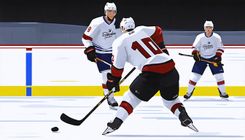NHLs New CBA Introduces Developmental Changes for Young Prospects

The current NHL collective bargaining agreement (CBA) is set to expire in September 2026. The potential implications of this timeline have raised concerns among long-time followers of the sport. However, in a significant development, NHL owners and the NHL Players Association reached an agreement on the framework for a new deal over the summer. While the complete Memorandum of Understanding for the new CBA has not yet been publicly released, NHL insider Frank Seravalli has highlighted a noteworthy change that stands to impact the league's prospect development landscape.
Once the new CBA comes into effect, each NHL team will have the opportunity to assign one 19-year-old prospect to their American Hockey League (AHL) team each season. Although at first glance, this may not appear to be a considerable increase, its ramifications for the development of NHL prospects could be profound. The shift marks a significant alteration from the current agreement with the Canadian Hockey League (CHL), which restricts drafted prospects from major junior leagues—the Ontario Hockey League (OHL), Western Hockey League (WHL), and Quebec Major Junior Hockey League (QMJHL)—from being assigned to the AHL or ECHL until they turn 20 years old or complete four seasons in the CHL. Notably, players drafted from other junior leagues and then later joining a CHL team are exempt from this stipulation.
This new policy, set to commence with the 2026-2027 season, will first impact players born in 2007. For example, Braeden Cootes, a prospect for the Vancouver Canucks, will turn 19 in February of 2026. Assuming the Canucks' management determines that his development may be better suited in the AHL rather than in the WHL, Cootes could be assigned to the Abbotsford Canucks in the fall of that year. The age-based criteria for this new rule suggest that a newly drafted player from the CHL could, quite feasibly, avoid returning to the CHL entirely if they turn 19 in the fall following their draft. A case in point would be Ryan Roobroeck, a projected top prospect for the 2026 draft. Given his September 2007 birthday, if Roobroeck signs his entry-level contract quickly and participates in his NHL team's development camp, his team may opt to assign him directly to the AHL instead of returning him to the Niagara IceDogs of the OHL. This development path offers CHL-affiliated players a new opportunity to advance their careers—an option that is increasingly essential for specific prospects. Historically, there has been recognition of the need for such developmental alternatives, illustrated by past instances like that of Dylan Strome, who could have benefited significantly from a similar pathway during his career.
Recent cases have demonstrated the effectiveness of this kind of developmental strategy. Cole Perfetti, for instance, played for the Manitoba Moose when the pandemic interrupted his season with the Saginaw Spirit of the OHL. Similarly, Shane Wright received an exceptional opportunity to compete with the Coachella Valley Firebirds of the AHL during the 2023-2024 season, despite having a challenging transition due to pandemic-related season cancellations. In both instances, players gained immense benefits from their time playing at a higher level rather than returning to the OHL or missing out on gameplay altogether. According to insiders, the newly introduced clause allows for the assignment of 'one player per organization per season.' Therefore, if a team assigns one 19-year-old player to the AHL, they cannot subsequently recall them or assign another player in the same season—although this situation is likely to arise infrequently. Typically, teams do not have multiple 19-year-old prospects simultaneously seeking more competitive development.
This change in policy presents notable advantages for NHL teams aiming to keep their top prospects closer for direct observation and development. However, for CHL teams, this could pose challenges. The limitation of one player per team may reflect the influence of the CHL itself, as franchises are naturally hesitant to lose their top talents. Despite each NHL team being restricted to a single assignment, there is no cap on the number of players taken from each CHL franchise. This approach could risk depleting resources from CHL teams with high-caliber players transitioning to the NHL.
The implications of this change could prove to be a setback for the CHL, compounded by previous adjustments to rules governing CHL to NCAA transfers. This situation could, however, be alleviated depending on the outcomes of recent executive orders concerning NIL (Name, Image, Likeness) regulations—a factor that may reshape the collegiate landscape. The introduction of this new developmental path allows for top CHL players to bypass the dilemma of needing to either push for NHL readiness or remain in the CHL. Young talents can now engage in professional hockey earlier, confronting their limitations while sharpening their skills at the professional level, as opposed to stagnating in the junior leagues.
An illustrative example of a team that could significantly benefit from this new assignment structure, albeit reluctantly, is the OHL's London Knights. As a historically successful team, the Knights consistently dominate their league, which can hinder their players' growth through necessary challenges. NHL teams observing this scenario may attempt to move their top 19-year-old prospects out of the Knights' successful environment and into the more demanding landscape of the AHL.
Moreover, this change could yield other unexpected benefits for players. According to Scott Wheeler, a prospect writer for The Athletic, multiple agents have indicated that players might prefer hopping to the AHL, complete with entry-level contract bonuses, over continuing their education in the NCAA. One CHL general manager highlighted that, contingent on specific CBA language, players may secure their arbitration rights a year earlier by choosing the AHL pathway at 19—an appealing prospect that would resonate with players and agents alike while posing challenges for NHL organizations. The prospective signing bonuses associated with this AHL move offer substantial appeal, particularly amidst uncertainty regarding future NIL opportunities related to educational institutions. AHL participation not only guarantees these players a signing bonus but also consistent salary compensation, eliminating the need to return to academia—a route far from appealing for many aspiring athletes.









